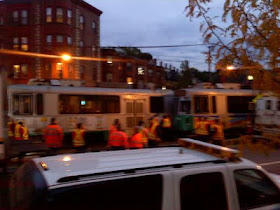 |
©2012 Boston to a T
|
Two years ago the MBCR, the company which operates the Commuter Rail for the MBTA, was plagued by numerous mechanical failures, which ranged from broken air hoses, locomotive failure, signal problems, trackage issues, and many other problems, leaving commuters stranded on platforms in the cold or stuck on trains for hours. The most famous incident that occurred that year was when a train bound for Worcester had its locomotive breakdown in Newtonville turning a regularly hour and a half ride into a four hour nightmare.
Currently the MBCR's largest obstacle for the winter months is keeping its fleet of aging locomotives, many of which are over 25 years old, in working order. Currently the agency has 76 active locomotives plus 1 ex-MARC unit being leased from Motive Power. During an average rush hour the MBTA needs exactly 60 locomotives to efficiently run service.
Just like last year, when extreme and severe weather hits the area, the MBTA will be implementing an emergency snow schedule. This schedule, which will have the commuter rail running less trains on each of their lines, will help the MBCR free up space on the tracks to allow for more crews to clear snow and debris. Less traffic on the rails will help crews get tracks cleared quicker so that trains can return to full service as fast as possible. The reduction of trains will also free up locomotives to serve as rescue trains. The one leased MARC locomotive will also give the MBCR a little bit of flexibility when it comes to mechanical failures, but according to the MBCR it will only be used in extreme emergencies.
Last year the MBCR invested around $500,000 into purchasing new and used snow equipment for the winter. The MBCR purchased a high powered and self propelled jet blower. This jet blower, similar to the MBTA's "Snowzilla", uses a high powered jet engine to clear and melt snow that accumulates on rails and switches.The jet blower can exhaust a heat of over 900 degrees F and can travel at a top speed of 25 mph. In addition to the self propelled jet blower, the MBCR has also acquired a new self propelled snow auger which can remove snow on tracks at a top speed of 45mph. Two smaller non-propelled jet blowers, which can be attached to a front end loader, were also purchased, along with a number of Kubota tractors and 32 Honda Snow blowers.
The MBCR has also invested in new protective sleeves that cover the air hoses and electrical wires that connect the locomotive to the coaches. These new sleeves will ensure that this sensitive equipment dose not receive any water damage. MBCR personnel at the Boston Engine Terminal (BET) have also designed a bag that will cover the coupler on the locomotive to protect it from snow and ice buildup. This bag will also make it easier, in the event of a mechanical failure, for a rescue train to attach to a disabled train.
Most of you know that last winter wasn't really a winter at all so it will be interesting what this winter will be like. The MBCR firmly believes that with this new added investment , Old Man Winter is going to be getting a run for his money. Although unpredictable failures can still cause major delays, the MBCR seems very well prepared to tackle any type of failure when, and if it happens. For a commuter rail system that still uses locomotives that are way over their estimated life expectancy on a daily basis I feel that they are doing a great job. Let's just hope this winter is going to be the same as last year.
For more information on how the MBTA and MBCR are preparing for winter check out: www.mbta.com/winter
Also, if you're on Twitter, tweet your questions and concerns to @MBCR_info or @MBTAGM.
You can see photos of the new winter equipment in the slideshow below as well as on our Facebook Page!












